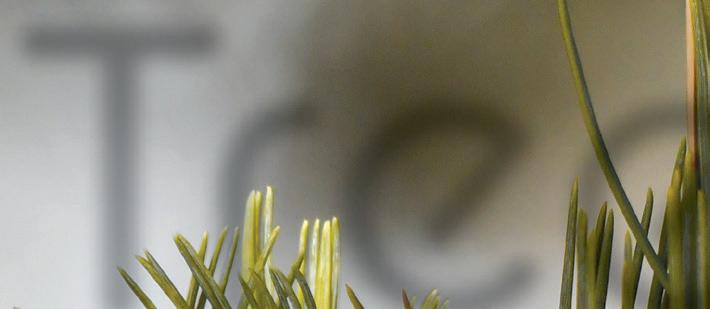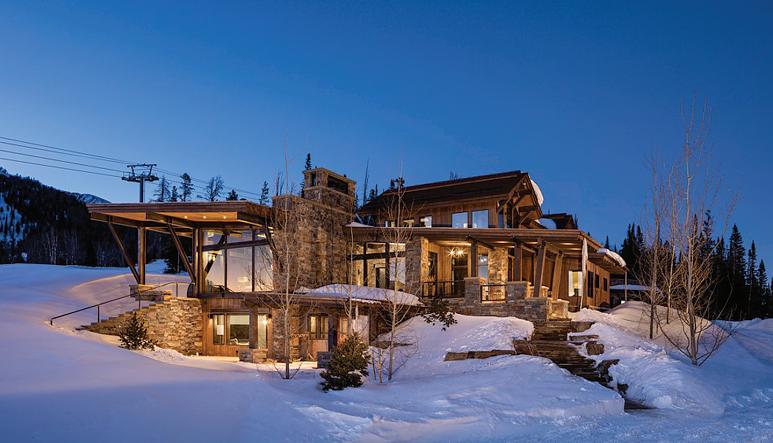
8 minute read
TREE CARE


The expert info you need to treat your trees this season
Spring is here and that means it’s time to get outside and check the health of your trees and garden. If you don’t already have trees in your yard, don’t worry. Bozeman Tree, Lawn & Pest Certifi ed Arborist John Noreika says tis’ the season to get growing.
“Early Spring is the best time to plant trees,” Noreika says. “The nurseries will be receiving fresh orders of trees so there will be a great selection of high quality nursery stock to choose from. ‘Bare root’ trees are available in the early spring and are the easiest and least expensive to plant because there are no heavy containers or root balls containing soil to wrestle with.”
Not sure where to plant your new trees? Noreika has a few rules of thumb to help you get started. The most important consideration, the expert arborist says, is matching the right tree to the location. Always remember, “Right tree, right place.” As an example, Noreika says you should never plant a large, maturing tree beneath an overhead power line.
“A smaller maturing variety such as a Japanese Tree Lilac will stay tidy beneath the power lines without need for regular clearance pruning that can destroy the aesthetics of a large maturing variety,” he says.
In low-lying areas with moist soil, plant trees that will perform best like a maple or birch tree. In upland areas with drier soils, plant drought tolerant trees like pine and juniper.
Once you’ve picked out the perfect tree for your yard (or you’re excited to get out there and care for what you’ve already got), it’s time to think about pruning. Now you may be wondering how exactly do you know what and how much to prune.
“Pruning is the most widely performed but also misunderstood practices in tree care,” Noreika explains. “The old rule of thumb is to remove no more than 25% of the trees’ live foliage or branches per pruning cycle (every two to fi ve years). But for an older or unhealthy tree, this may be too much, and for a young vigorous tree, not enough. Pruning can be one of the best things you can do for a tree or the worst depending on how and when it is done.”
Because a one-size-fi ts-all approach won’t work for pruning, Noreika advises conducting some research on your tree. But don’t trust everything you see on the internet. Noreika and other tree experts recommend turning to reliable resources like university extension services or the International Society of Arboriculture (ISA). Arborists at the ISA offer these tree pruning tips to help you carefully cut this Spring.
1. Always have a purpose in mind before making a cut. Each cut has the potential to change the growth of the tree.
1. Poor pruning can cause damage that lasts for the life of the tree.
Learn where and how to make the cuts before picking up the pruning tools.
2. Trees do not heal the way people do. When a tree is wounded, it must grow over the damage. As a result, the wound is contained within the tree forever.
3. Small cuts to the tree do less damage than large ones.
Correcting issues when a tree is young will reduce the need for more drastic pruning later.
If you’d rather have some inperson help, Noreika, an ISAcertifi ed arborist himself, teaches introductory pruning classes at Cashman Nursery each Spring and hopes to resume classes soon. In the meantime, Noreika says it’s a good time to reach out to a certifi ed arborist who can offer a tree inspection.
While you gather tips on planting and pruning, it’s imperative to keep safety in mind at all times.
“Tree pruning can be a very dangerous activity,” Noreika warns. “If you ever fi nd yourself on a ladder with a chainsaw, stop immediately and call an ISA-certifi ed arborist before you hurt yourself or your tree!”
Once your trees are safely and properly trimmed, it’s time to think about watering. As with pruning, a tree’s watering requirements vary.
“A newly planted tree may need relatively small amounts of water but very frequently during the summer (5-10 gallons every day),” Noreika says. “Whereas a large, mature tree may need hundreds or Other tree watering considerations include soil and drainage around the tree. In a fl at area with clay-based soil or a spot with poor drainage, even a newly planted tree may not need much water. Conversely, in a welldrained, sloped area with sandy or silty soil, a tree of any size may need daily watering during the dog days of summer, Noreika explains.
For large trees, remember that roots can spread far from the base of the trunk. So placing a hose at the base of a mature tree does little to provide water to the absorbing roots that can be 50 or more feet away from the trunk. To give large trees the moisture they need, water the entire area beneath the “drip line,” and thoroughly soak the soil to be sure water reaches the right depth for the roots.
Here are a few more watering reminders from Noreika:
• Constantly wet soil can be just as bad for a tree as perennially dry soil.
• The soil should be moist to the touch but not soggy or bone dry.
• Don’t forget to water “native” trees during hot, dry summer months.
Native forests often struggle with pest and disease infestations that are made worse by prolonged periods of drought. Your Montana trees will need plenty of drinks on toasty summer days, too!
Once you’ve found the right trees, fi gured out a plan of attack for watering and pruning, it’s time to think about mulch. Noreika says proper mulching is one of the best things you can do for your trees. But beware a common mulch mistake many make. Do not plant grass right up to the base of your tree’s trunk.
“Turf grasses can really compete with young trees for water and nutrients,” he explains. “Young trees grown with turf grass planted up to the trunks may only grow half as fast as trees with mulch around the base. Mulches composed of natural materials such as bark provide tremendous benefi ts to trees as they conserve water, suppress weeds, provide organic matter and nutrients, and help prevent mechanical damage from mowing practices.”
Steer clear of inorganic mulches like rocks and synthetic products. These mulches do little to help trees and in some cases can harm the tree. Similarly, Norieka does not advise the use of weed mat or plastic as an underlayer to the mulch.
“Never pile mulch against the trunk forming a ‘mulch volcano’ as this can damage the trunk and allow diseases to attack it,” Noreika warns. “Protect your bark and trunks! The bark is the tree’s Achilles’ heel.”
Noreika explains that tree bark, or phloem layer, that surrounds the wood of the tree is the essential conduit for sugars and carbohydrates produced via photosynthesis in the leaves to travel down the trunk to the tree’s roots.
“If anything damages the bark of the trunk, the results can be catastrophic,” he says. “The number one killer of young trees in the urban environment is the modern string trimmer. The bark layer of a young tree can be very thin, one quarter of an inch or less, so just one pass

around the circumference of the trunk with the string trimmer can mean a slow death of the tree.”

Mulching and a simple trunk guard or wrap can help avert this catastrophe. Wrap a trunk guard from the soil up to six feet on the trunk to deter pesky deer and voles from rubbing and chewing your tree. It’s ideal to wrap your tree in late August and leave the guard on until early Spring.

For more questions about your trees’ health, consult with your local ISA-certifi ed arborist and visit the website www.treesaregood.org. The City of Bozeman also offers a guide with planting recommendations available on the city’s website (search “tree guide” to get there quickly from Bozeman.net). Additionally, local nurseries and garden centers can offer guidance as well as resources like the MSU Extension Service (msuextension.org).
WE CAN BUILD YOUR DREAM HOME! REALTORS,WE CAN BUILD YOUR CLIENT’S HOME! HEUER HOMES, LLC



I build homes with an Off-Site Construction System. Our homes are extremely energy efficient, built equvalent to or superior to homes built on site.You can have a quality custom designed home. HeuerHomesLLC.com
Let me serve your real estate needs Visit our global affordable housing solutionwww.internationalhomerelief.org NOW TAKING ORDERS FOR TINY HOMES!
SERVING M0NTANA
Mitch Heuer - Heuer Homes LLC Builder-REALTOR® Kelly Right Real Estate 406.223.3442 Heuerhomesllc.com
Quality Custom Work - Since “1981”

80650 Gallatin Rd., Bozeman, Montana, 59718 406-522-7251 office@rdavidsonmasonry.com


Cabinetry -andFurniture
Good People Good Design





